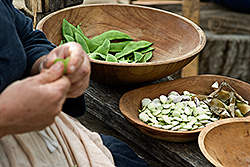Page content
Historic Farming
Other Crops

Interpreter Pam Warthen snaps beans and peas in bowls outside the kitchen at Great Hopes Plantation.
In addition to the three most important agricultural crops of tobacco, corn, and wheat, colonial Chesapeake plantations and farms also produced a host of generally less-valuable field crops.
Most common of these would be the orchard crops of apples, peaches, pears and plums in that order. Of these, apples found their way into large quantities of domestically consumed cider, and peaches to distilled brandy and hog food.
Pea and bean production was often associated with cornfields, being planted between (or sometimes within) the corn hills. Other times such “pulse” was grown independently. “Black-eyed” peas were commonly produced. In 1772 almost 20,000 bushels of peas and beans were exported from Virginia; most went to the British and foreign West Indies.
Oats were the second-most commonly grown small grain, normally destined for local horse feed. However, 13,000 bushels also were exported to other North American colonies and Caribbean markets in 1772. Small amounts of rye and barley (for local brewing) were sometimes produced as well.
Fiber crops were produced periodically, particularly during periods of non-importation or geographic isolation (in frontier locations). Production of cotton, flax and hemp, and the local processing and consumption of these materials, would be most commonly seen on Tidewater and Piedmont farms during the War years. However, some planters and farmers produced fiber crops routinely during all periods.
Very little of these fiber crops were exported, but rather prepared, spun and woven into coarse cloth and cordage for domestic and local use. During the War years one would be proud to announce that they were wearing “Virginia cloth.”
“Patch” crops of two to 10 acres most commonly included sweet and Irish potatoes, turnips and pumpkins. These were generally grown as supplemental livestock feed. Occasionally small amounts of cabbages, carrots and melons were produced in larger than garden-scale plots of land for local markets or home consumption.
Non-native pasture crops of timothy, orchard, and other grasses were sometimes produced for livestock hay supplements. Progressive planters also experimented with such imports as clover, alfalfa, burnet, vetch, trefoil, and Bermuda grass.
One or several of the above crops often supplemented the staples of corn, wheat and tobacco. Such secondary crops were either used on the farm where produced, sold locally or regionally, or sometimes exported great distances.
